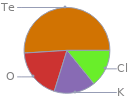Input interpretation

potassium hexachlorotellurate | elemental composition
Result

Find the elemental composition for potassium hexachlorotellurate in terms of the atom and mass percents: atom percent = N_i/N_atoms × 100% mass percent = (N_im_i)/m × 100% Plan: • Write the chemical formula and gather atomic masses from the periodic table. • Determine values for N_i, m_i, N_atoms and m using these items. • Finally, compute the percents and check the results. Write the chemical formula: K_2TeCl_6 Use the chemical formula to count the number of atoms, N_i, for each element and find the total number of atoms, N_atoms, per molecule: | number of atoms Cl (chlorine) | 6 K (potassium) | 6 O (oxygen) | 18 Te (tellurium) | 6 N_atoms = 6 + 6 + 18 + 6 = 36 Divide each N_i by N_atoms to calculate atom fractions. Then use the property that atom fractions must sum to one to check the work: | number of atoms | atom fraction Cl (chlorine) | 6 | 6/36 K (potassium) | 6 | 6/36 O (oxygen) | 18 | 18/36 Te (tellurium) | 6 | 6/36 Check: 6/36 + 6/36 + 18/36 + 6/36 = 1 Compute atom percents using the atom fractions: | number of atoms | atom percent Cl (chlorine) | 6 | 6/36 × 100% = 16.7% K (potassium) | 6 | 6/36 × 100% = 16.7% O (oxygen) | 18 | 18/36 × 100% = 50.0% Te (tellurium) | 6 | 6/36 × 100% = 16.7% Look up the atomic mass, m_i, in unified atomic mass units, u, for each element in the periodic table: | number of atoms | atom percent | atomic mass/u Cl (chlorine) | 6 | 16.7% | 35.45 K (potassium) | 6 | 16.7% | 39.0983 O (oxygen) | 18 | 50.0% | 15.999 Te (tellurium) | 6 | 16.7% | 127.60 Multiply N_i by m_i to compute the mass for each element. Then sum those values to compute the molecular mass, m: | number of atoms | atom percent | atomic mass/u | mass/u Cl (chlorine) | 6 | 16.7% | 35.45 | 6 × 35.45 = 212.70 K (potassium) | 6 | 16.7% | 39.0983 | 6 × 39.0983 = 234.5898 O (oxygen) | 18 | 50.0% | 15.999 | 18 × 15.999 = 287.982 Te (tellurium) | 6 | 16.7% | 127.60 | 6 × 127.60 = 765.60 m = 212.70 u + 234.5898 u + 287.982 u + 765.60 u = 1500.8718 u Divide the mass for each element by m to calculate mass fractions. Then use the property that mass fractions must sum to one to check the work: | number of atoms | atom percent | mass fraction Cl (chlorine) | 6 | 16.7% | 212.70/1500.8718 K (potassium) | 6 | 16.7% | 234.5898/1500.8718 O (oxygen) | 18 | 50.0% | 287.982/1500.8718 Te (tellurium) | 6 | 16.7% | 765.60/1500.8718 Check: 212.70/1500.8718 + 234.5898/1500.8718 + 287.982/1500.8718 + 765.60/1500.8718 = 1 Compute mass percents using the mass fractions: Answer: | | | number of atoms | atom percent | mass percent Cl (chlorine) | 6 | 16.7% | 212.70/1500.8718 × 100% = 14.17% K (potassium) | 6 | 16.7% | 234.5898/1500.8718 × 100% = 15.63% O (oxygen) | 18 | 50.0% | 287.982/1500.8718 × 100% = 19.19% Te (tellurium) | 6 | 16.7% | 765.60/1500.8718 × 100% = 51.01%
Mass fraction pie chart

Mass fraction pie chart